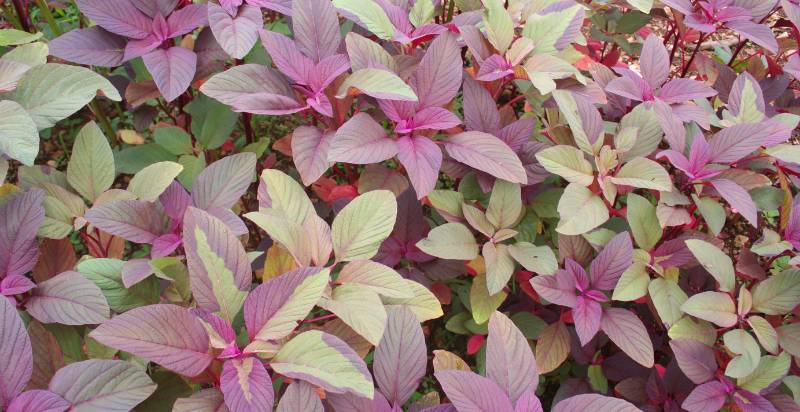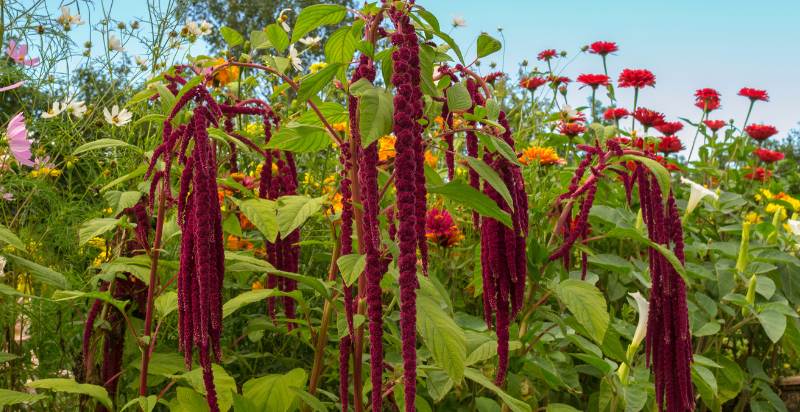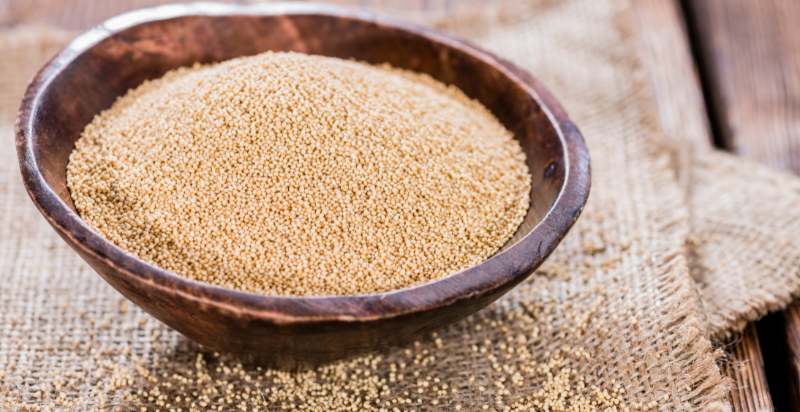Amaranth is an ancient grain that has been used for centuries worldwide. It was one of the staple grains in the Aztec diet, as well as a symbol of fertility and eternity to them. It is becoming increasingly popular due to its nutritional profile and versatility. This article will provide an overview of amaranth, its history and uses, nutrition facts, and how to cook with it.
What is Amaranth?
Amaranth is an ancient grain that comes from the amaranthus family of plants. It is technically a pseudocereal, meaning it is not technically a cereal grain but can be used similarly to grains. Its seeds are much smaller than traditional cereals and have a mild, nutty flavor. Amaranth has been cultivated for thousands of years, with evidence dating back to 6500 BCE in Mexico.
History and Uses of Amaranth:
Amaranth originated in South America thousands of years ago and was a significant part of the diets of several pre-Columbian civilizations, including the Aztecs. The Spanish conquistadors eventually destroyed most of their crops during their attempts to colonize Central America; however, some survived in remote areas of the Andes Mountains.
Amaranth is a popular grain due to its high protein content and many health benefits. It is gluten-free, making it ideal for those with allergies or sensitivities to wheat or other grains. In many dishes, it can also be used as an alternative to rice, quinoa, or couscous. Additionally, it can be popped like popcorn and added to cereals or snacks for a crunchy texture.
Types of Amaranth:
There are several types of amaranth, including common varieties such as red and white, black, purple, and green. Each type has a slightly different flavor profile and can be used in various recipes. Red and white amaranth is the most common variety found in grocery stores.
Nutritional Facts of Amaranth:
Amaranth is an ancient grain with a plethora of nutritional benefits. It is a gluten-free grain rich in protein, dietary fiber, vitamins, and minerals. In one cup (246g) of cooked amaranth, there are 251 calories, 5g of fat, 44g of carbohydrates, and 9g of protein. Amaranth also contains a good amount of other nutrients, including:
- Vitamin B6 – 8% of the daily value (DV)
- Iron – 21% DV
- Magnesium – 30% DV
- Folate – 19% DV
- Manganese – 28% DV
- Phosphorus – 24% DV
- •Copper – 20 % DV
Amaranth is also high in antioxidants that can help reduce inflammation and protect against disease. It is beneficial for lowering cholesterol levels, regulating blood sugar levels, improving digestion, and aiding in weight loss. Amaranth is an excellent source of plant-based protein and can be used in recipes instead of rice or wheat. It is also ideal for adding to smoothies, cereals, and salads.
Uses of Amaranth:
Amaranth is a nutrient-dense food with many uses in the kitchen. It can be used as an ingredient in breakfast cereals, soups, salads, and stews or as a flour alternative in baking. Amaranth also makes a hearty porridge that can be eaten on its own or served with fruit and nuts for added flavor and nutrition. Its high content of essential minerals such as magnesium, iron, and zinc benefits overall health.
Amaranth also has potential medicinal benefits due to its anti-inflammatory and antioxidant properties. Studies have suggested that amaranth may help reduce cholesterol levels, improve digestive health, balance hormones, regulate blood sugar levels and protect against certain cancers.
Amaranth is also a nutritious source of vegetarian protein. It provides all nine essential amino acids, making it a complete protein. This makes amaranth an ideal plant-based protein source for vegetarians and vegans.
Amaranth can be cooked in many different ways, such as boiling, baking, or roasting. The small seeds taste nutty and pair well with sweet and savory dishes. Amaranth flakes can make healthy granola bars and are often added to breads, muffins, and cookies for extra crunch. Its mildly sweet flavor also lends itself to breakfast cereals, porridges, and desserts like puddings and pastries.
Amaranth is a healthful and versatile food that can be enjoyed in many different ways. Its high nutrient content makes it an ideal addition to any diet, offering potential medicinal benefits along with sources of vegetarian protein and essential minerals.
How to Plant Amaranth?
Amaranth is a fast-growing, annual herb grown for its edible leaves, seeds, and stems. It is an ancient grain that was once a staple in the diets of the Aztecs and Incas. Amaranth can be used as cereal or flour, added to soups and salads, or popped like popcorn for a crunchy snack. Planting amaranth seeds can result in high yields with little effort.
Sowing:
Amaranth prefers light soils with adequate drainage and warm weather. To start from seed, sow the seed indoors four to six weeks before the last expected frost date or directly outdoors two weeks after your last frost date when soil temperatures reach at least 60°F (15°C).
Outdoor Planting:
When planting amaranth plant outside, sow the seeds ½ inch deep in rows spaced two feet apart. When seedlings appear, thin them to one plant every twelve inches in the row. Water and fertilize regularly, using a balanced fertilizer or organic compost.
Indoor Planting:
If you’re starting your seed indoors, use biodegradable peat pots filled with potting soil to ensure you won’t damage roots when transplanting outdoors later on. Fill each pot with soil, press three to four seeds into the soil’s surface, loosely cover with some more soil, and water lightly. Place near a window where they can receive plenty of light but keep the soil evenly moist.
Amaranth is ready to harvest when plants are 18 inches tall and leaves are dark green. Cut stems at the base of each plant with a sharp knife or scissors and hang them upside down in an airy, shady place until dry. Once fully dried, the seed heads can be threshed, and the grain separated from the chaff. Leaves can be eaten fresh or cooked, like spinach. The seeds can be cooked as whole grain cereal or popped like popcorn for a crunchy snack. Store both amaranth leaves and grains in sealed containers away from sunlight for later use.
With its attractive foliage, amaranth makes a great ornamental plant as well. Growing amaranth is an easy and rewarding endeavor that can result in a plentiful harvest of leaves and grain with little effort or maintenance. Planting amaranth is the perfect way to add ancient nutrition to your garden.

How to Care for and Grow Amaranth?
Amaranth is a beautiful, versatile, and easy-to-care-for plant that can be grown inside and out. Here are some tips for caring for amaranth:
- Planting – Amaranth can be planted directly in the ground or containers. When planting in the ground, choose a sunny location with well-draining soil. When planting in containers, make sure they are large enough to accommodate the spreading habit of this plant. Be sure to water plants thoroughly after planting and then once per week during dry periods.
- Fertilizing – It’s best to fertilize your Amaranth every six weeks with a balanced 10-10-10 fertilizer. Avoid over-fertilizing, as this can cause root burn.
- Pest Control – Check your Amaranth plants regularly for pests. If you find any, treat them with insecticidal soap or neem oil.
- Pruning – To keep your Amaranth looking its best and encourage healthy growth, it’s a good idea to prune back the dead foliage periodically throughout the growing season.
- Harvesting – When harvesting Amaranth, be sure to wait until the seeds are dry and brown before cutting off heads with scissors or shears. You can also harvest leaves for salads or cooking during the growing season by snipping off leaves at the base of each stem.
By following a few simple guidelines and giving your Amaranth plenty of light, water, and fertilizer, you can easily grow a beautiful and bountiful plant for years to come!

Preventions from Pests and Diseases:
Amaranth is a tough plant but can still be affected by the occasional pest or disease. Here are some tips to keep your amaranth plants healthy and problem-free:
- Crop Rotation – To avoid having pests build up in the soil over time, practice crop rotation by planting different vegetables in different spaces each year. This will help reduce the risk of infestation.
- Sanitation – Be sure to remove any dead leaves or stems from around your amaranth plants, as this can attract pests and diseases. Additionally, it’s important to keep tools clean, so you don’t spread unwanted organisms between plants.
- Mulching – Applying a layer of mulch around your plants can help to discourage pests and protect soil moisture levels.
- Watering – Water your plants at the soil level, not over the foliage as this can spread disease. Additionally, ensure only water when necessary and avoid getting the leaves wet if possible.
By following these tips and keeping an eye out for any signs of pest or disease infestation, you can ensure that your amaranth crop stays healthy and productive!
Harvesting Amaranth for Seed:
Amaranth greens can be harvested when the seed heads are dry and start to break apart. Wear gloves to protect your hands from the prickly seed heads, and use scissors or shears to cut off the seed head at the base. Place them in a paper bag and allow them to dry for another few days before storing them in an airtight container away from direct sunlight. The seeds should keep up to one year if stored properly.
Amaranth greens is an easy-to-grow, nutritious plant that can be used as a food source and a decorative ornamental. With its vibrant foliage and high nutrient content, amaranth is worth adding to your garden this season. Remember to practice proper care and maintenance; you’ll be harvesting a bountiful crop of amaranth in no time!
How to Store Homegrown Amaranth?
Homegrown amaranth can be stored in an airtight container, such as a Mason jar or plastic food storage container. Be sure to store them in a cool, dry place away from direct sunlight and moisture. Amaranth can also be frozen for long-term storage. To freeze it, simply spread the amaranth grains on a baking sheet and flash freeze for 30 minutes.
Then transfer it to an airtight bag or container and store it in the freezer until you’re ready to use it. If you plan to cook your amaranth directly from the freezer, there is no need to thaw it first – add it straight into the pot! If you’re using it for something other than cooking purposes (like making amaranth milk), you will need to thaw the grains first. The best way to do this is to place it in a bowl of warm water for about 10 minutes, drain it, and then use it as desired. With proper storage, homegrown amaranth can last up to two years without any significant loss of flavor or texture.

How to use Homegrown Amaranth differently?
Amaranth can be enjoyed in many ways and makes a great addition to any meal. Here are some ideas for using homegrown amaranth:
- Amaranth Flour: Use the flour to replace wheat flour in baking recipes or mix it with other flour for added nutrition and flavor. It can also be used as a thickener in sauces and soups.
- Amaranth Porridge: Make a hot cereal by boiling whole amaranth seeds in water until they become creamy and soft. Sweeten with maple syrup or honey, stir in cinnamon and raisins, and top with your favorite fruit or nuts – delicious!
- Amaranth Pops: These are a fun, healthy snack! Toast amaranth seeds in the oven on low heat for about an hour, stirring occasionally. Cool and stir in your favorite spices, such as cinnamon or chile powder. Roll into balls and coat with melted coconut oil or butter. Bake at 350 degrees until golden brown and crunchy – yum!
- Amaranth Salad: Mix cooked amaranth with diced vegetables such as carrots, onions, bell peppers, and tomatoes. Add lemon juice, olive oil, herbs, and spices to make a tasty side dish or main meal.
- Amaranth Pizza Crust: Use ground amaranth flour instead of wheat flour to make a gluten-free pizza crust. The result is a crispy, chewy crust that pairs well with any topping.
These are just a few ways to enjoy homegrown amaranth in your kitchen. Have fun experimenting and find out what works best for you.

Potential Risks from Amaranth:
Amaranth is generally safe for most people to consume; however, it can cause allergic reactions in some individuals. It’s also important to note that amaranth does contain high levels of oxalates, which can be problematic for people with certain health conditions such as kidney stones or gout.
People on blood thinning medications should speak with their doctor before adding amaranth to their diets since it may interact with the medication. Lastly, cooking amaranth with too much oil or fat could significantly increase calorie and fat intake. As always, moderation is key when using any food item.
Conclusion
Amaranth is a nutritious, gluten-free grain that can be enjoyed in many forms. From amaranth flour to amaranth pops, this ancient crop offers plenty of options for incorporating into your diet. With proper care and storage, homegrown amaranth can last up to two years without any significant loss of flavor or texture – so get growing! Enjoy the health benefits and culinary possibilities of homegrown amaranth today.
- Everything You Wanted to Know About Red Tamarillos - June 2, 2025
- A Guide to Tulips: Everything You Need to Know & More… - June 2, 2025
- Guanabana: Description, Flavor, Benefits, And Uses - May 27, 2025

2 thoughts on “What is Amaranth? How to Plant, Grow, and Harvest Amaranth Greens ”
Comments are closed.